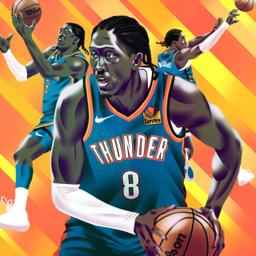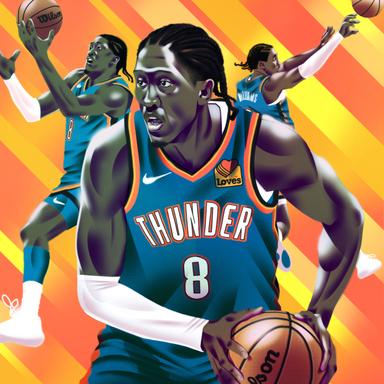Jalen Williams has met his moment. It hasn’t always been perfect for the Thunder forward in these playoffs, and it certainly hasn’t been easy. But it’s not supposed to be; what makes a star a star is the way they manage the most difficult aspects of the game at the highest levels of competition—when the needs of the matchup transcend luxuries like efficiency. Stars are born when someone just has to make a play. Get a bucket. Get a stop. Get the ball with two minutes left and no room for error, and make something happen:
There are many reasons why the Thunder—after beating the Timberwolves 128-126 on Monday night—now find themselves one win away from the NBA Finals. An incredible number of those reasons involve Williams. His versatility on defense holds lineups together. His playmaking keeps the Thunder in motion. The 34 points he dropped in Game 4—a personal playoff best—didn’t hurt, either. Williams, at 24 years old, is coming into his own. He may not have the same level of creative responsibility as Shai Gilgeous-Alexander, but Williams drives so much of what sets OKC apart.
Just take this critical Game 4. Minnesota’s defense is incredibly tough to crack—a front of rangy, aggressive defenders backboarded by one of the most accomplished rim protectors in NBA history. Yet Gilgeous-Alexander and Williams dovetailed their work off the dribble into a nonstop attack, completely dismantling that defense from within. A close game wound up disguising the fact that the Wolves allowed more points per possession in Game 4 than in any playoff game this year—the second-worst mark of their entire season. Shai was in MVP form, but J-Dub matched him bucket for bucket in a way that turned the Thunder offense into something overwhelming. Williams has become the fulcrum of this OKC team, in both style and production.
It’s Williams, after all, who allows the Thunder to play so much bigger than they actually are. His day-to-day responsibilities usually involve taking on the most physically punishing matchup on the floor. Someone has to stand in there and absorb battering-ram blows from Julius Randle, so the Thunder call on their 6-foot-5 welterweight. No defender in the league is more diligent in fighting for position than Williams. If anyone is going to post him up, they’ll have to start from 18 feet out and battle for every inch. And once they get the ball, they’ll have to contend with Williams in fire-hydrant mode, crouching so low that he’s impossible to budge. It’s a miracle of leverage that the Thunder wing routinely holds off opponents 4 to 5 inches taller and 30 to 40 pounds heavier. Randle is a tremendously skilled player on the playoff run of his life, but after four games against Williams, he looks completely lost.
Williams’s ability to neutralize the size advantage of Randle or of the even bigger Naz Reid is what allows the Thunder to move Chet Holmgren (and his roving contests) all around the floor. That formula paid off handsomely in Game 4, as the Thunder leaned less on Isaiah Hartenstein in the second half—even against a big Minnesota front line. It’s as if Oklahoma City decoupled the work of defending opposing bigs from protecting the rim. While Williams grapples with the bruisers, Holmgren lurks behind as a safeguard against any threat that might develop. That, in turn, empowers the other Thunder defenders to swarm the ball and jump every passing lane. What looks like a feeding frenzy is actually a work of impeccable design.
And none of it works without Williams clocking in for full nights of hyperphysical, high-leverage defense. Williams’s shot has faltered at times in these playoffs—particularly in the Denver series—but his all-around contributions never do. This kind of scoring just takes his play to a different, altogether more dominant level. "Basketball is so much more than scoring and making the heroic play every time,” Williams told reporters after Game 4. “There [are] so many things that go into a game that you can be good at and impact the game.” When Williams moonlit as a center for the injury-depleted Thunder back in November, his stint felt like a manifestation of OKC’s whatever-it-takes resolve. Now it’s just a normal part of the Thunder rotation—and quite successful, even against all of Minnesota’s size.
These playoffs feel, in many ways, like the realization of the Thunder project. The 95 combined points scored by Shai, J-Dub, and Chet in Game 4 were, per ESPN, the most by a Thunder trio in any playoff game in franchise history. Considering OKC’s notable alumni, that’s quite an achievement. And they reached it by allowing Williams and Holmgren to explore the range of their ability. Both young stars have had room to try things. They’ve had room to fail. They were never locked into a defined role but played one that was shaped around whatever they proved they could handle. The Thunder never made a panic move for a secondary creator. They simply gave Williams, who is just in his third NBA season, the space to become the creator they needed him to be.
It’s not an accident that Williams and the Thunder are now emerging together: an All-NBA campaign that fed a 68-win season, and a playoff showing that could help send OKC to the Finals. The Thunder are ready because Williams is ready. They’re beating bigger teams and more experienced teams and now one of the league’s most stifling perimeter defenses, as if refuting the list of their supposed weaknesses. Nothing seems to hold the Thunder down anymore. They’ve shape-shifted their way through styles and alignments, answering every call as they go. And with every adjustment, the Thunder ask something different of Williams—for the simple, transformative reason that they know they can.





